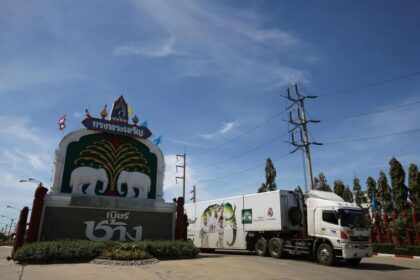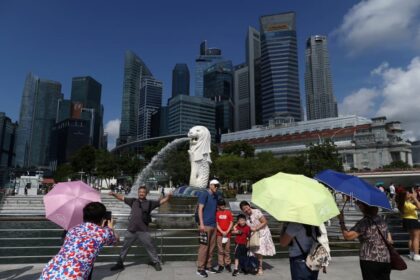Introduction: A Demographic Turning Point for Malaysian Chinese
Malaysia’s Chinese community is facing a profound demographic shift. Over the past two decades, the birth rate among Malaysian Chinese has plummeted by 60%, transforming the community’s age structure and raising urgent questions about the future of Chinese education, cultural identity, and social cohesion. This trend is not unique to Malaysia—Chinese communities worldwide are experiencing similar declines—but its effects are particularly acute in a country where Chinese vernacular schools have long been a pillar of cultural preservation and social mobility.
- Introduction: A Demographic Turning Point for Malaysian Chinese
- Why Is the Malaysian Chinese Population Declining?
- The Impact on Chinese Education: Shrinking Enrolment and Shifting Identity
- Existential Questions: Preserving Culture or Adapting to Change?
- Comparative Context: Other Ethnic Communities and Global Trends
- Broader Implications: Aging, Social Care, and Economic Development
- Community Responses and the Path Forward
- In Summary
Recent data from the Department of Statistics Malaysia (DOSM) and research by the Centre for Malaysian Chinese Studies (Huayan) highlight the scale and speed of this transformation. In 2000, there were 115,000 Chinese newborns in Malaysia; by 2023, that number had dropped to just 45,000. The total fertility rate (TFR) for Chinese women is now 0.8, far below the replacement level of 2.1. This demographic reality is reshaping not only the community’s future but also the very nature of Chinese education in Malaysia.
Why Is the Malaysian Chinese Population Declining?
The causes of the declining birth rate among Malaysian Chinese are complex and multifaceted. While economic pressures—such as the high cost of raising children and providing quality education—are often cited, deeper social and cultural changes are at play.
Associate Professor Chin Yee Mun of Tunku Abdul Rahman University points to a shift in values: the embrace of a capitalist economic model, changing attitudes toward marriage and family, and a reinterpretation of traditional beliefs have all contributed to a preference for smaller families or childlessness. Many young Chinese Malaysians now prioritize career advancement and financial stability, often delaying or forgoing marriage and parenthood altogether. This mirrors trends seen in other developed societies and among Chinese communities globally.
Additionally, modernization and exposure to new ideas have led to a weakening of traditional religious and cultural practices, further eroding the social structures that once encouraged larger families. A study on traditional Chinese religions in Malaysia found that many Chinese Malaysians now identify as Buddhist, Taoist, or followers of Chinese folk religions in name only, with limited conviction or commitment. This cultural drift, combined with the appeal of alternative lifestyles and belief systems, has accelerated demographic decline.
The Impact on Chinese Education: Shrinking Enrolment and Shifting Identity
Perhaps nowhere is the impact of demographic decline more visible than in the realm of Chinese education. Malaysia is unique outside of China and Taiwan in maintaining a comprehensive Chinese education system, from primary schools (SJKC) to independent secondary schools and even Chinese-language universities. These institutions have historically served as bastions of Chinese language, culture, and community solidarity.
However, the sharp drop in Chinese births is now translating into falling enrolment numbers. In 2024, only 41,270 Chinese babies were born—a number that, when distributed across the country’s 1,304 SJKCs, averages just 32 new Year One pupils per school by 2031. Many schools, especially in rural areas, are already classified as “under-populated,” with fewer than 150 students. Some have fewer than 30, and a handful have less than 10.
This trend is even more pronounced at the secondary level. If only half of the 2024 cohort eventually enter independent Chinese secondary schools, the average intake per school will be just over 300 students, making large, vibrant school communities increasingly rare. The reality is that, unless there is a dramatic rebound in birth rates, many Chinese schools will face closure or consolidation in the coming years.
Non-Chinese Enrolment: A Double-Edged Sword
As the number of Chinese students declines, Chinese schools are seeing a significant rise in enrolment from non-Chinese students, particularly Malays. According to research by the ISEAS-Yusof Ishak Institute and other sources, the proportion of non-Chinese students in SJKCs has grown from 3-6% in the 1990s to about 20% by 2020, with Malays making up the majority of this increase. In some rural schools, Malays now constitute the majority of students.
This shift is driven by several factors:
- Academic Reputation: Many Malay parents perceive Chinese schools as offering higher academic standards, stricter discipline, and better prospects for their children.
- Mandarin Proficiency: With China’s economic rise, Mandarin has become a valuable skill in Malaysia’s job market. Job listings requiring Mandarin now account for over 20% of all postings, and Malay job seekers with Mandarin skills enjoy a significant advantage.
- Declining Chinese Enrolment: As Chinese student numbers fall, schools are more open to non-Chinese enrolment to maintain viability.
To accommodate the growing diversity, many SJKCs have introduced halal food options, Islamic classes, bilingual communication, and other supportive measures. While these adaptations help keep schools open, they also raise existential questions about the future identity and mission of Chinese education in Malaysia.
Existential Questions: Preserving Culture or Adapting to Change?
The influx of non-Chinese students into Chinese schools presents a dilemma for the Chinese community. On one hand, it ensures the survival of these institutions in the face of demographic decline. On the other, it challenges their traditional role as transmitters of Chinese language and culture.
Some educationists and community leaders argue that excessive accommodation to non-Chinese pupils risks diluting the cultural essence of SJKCs, reducing them to mere language schools rather than vibrant centers of Chinese heritage. Others take a more pragmatic view, seeing adaptation as necessary for survival. As one analysis notes, “without such accommodation, many SJKCs face the gloomy reality of closure.”
In practice, most schools are finding a middle ground: maintaining core Chinese features while introducing necessary adaptations. However, as the proportion of non-Chinese students continues to rise, the balance between cultural preservation and inclusivity will become increasingly difficult to maintain.
Political and Social Implications
The demographic shift also has broader political and social implications. The declining Chinese population reduces the community’s bargaining power in national debates over education policy, minority rights, and cultural preservation. At the same time, the growing diversity within Chinese schools may weaken arguments for their abolition, as they increasingly resemble the multicultural national schools that government policy has long promoted.
Yet, the existential question remains: does preserving vernacular schools at the expense of their core cultural mission represent a genuine victory or a hidden loss for the Chinese community?
Comparative Context: Other Ethnic Communities and Global Trends
The challenges faced by Chinese schools are not unique. Tamil schools in Malaysia are experiencing similar pressures due to declining birth rates among the Indian community. The Penang Hindu Association, for example, has warned that many Tamil schools may become “Sekolah Kurang Murid” (schools with low enrolment), risking closure and loss of cultural heritage.
Globally, Chinese communities in other countries are also grappling with falling birth rates and aging populations. Dr. Wee Ka Siong, president of the Malaysian Chinese Association, notes that “the Chinese in many parts of the world, they don’t have many kids.” This is a personal choice shaped by economic, social, and cultural factors, and it is leading to similar debates about the future of Chinese education and identity elsewhere.
In Taiwan, for instance, the number of Malaysian students is declining due to both demographic changes and increased opportunities for Chinese-language education at home. Meanwhile, Malaysia is seeing a surge in international students from China and other Asian countries, attracted by affordable costs and the country’s multicultural environment. This influx is reshaping the demographic landscape of international schools and higher education institutions, adding another layer of complexity to the education system.
Broader Implications: Aging, Social Care, and Economic Development
The demographic decline among Malaysian Chinese is not just an educational issue—it has far-reaching implications for social care, economic development, and community well-being. As the community ages, the demand for elder care services is rising, placing new burdens on families and social institutions. The proportion of Chinese Malaysians aged 65 and above is now 10%, higher than the national average and other ethnic groups.
Without adequate policy intervention and community support, many families will struggle to provide care for elderly members, especially those with disabilities. The cost of long-term care can range from RM2,500 to RM8,000 per month, far beyond the means of most middle- and low-income households. This situation underscores the need for a more robust welfare state and community-based care systems.
From an economic perspective, the declining number of children and working-age adults threatens Malaysia’s long-term growth and competitiveness. As highlighted by The Edge Malaysia, investing in education and human capital is more critical than ever to ensure a skilled workforce and social stability. The exclusion of non-citizen children from formal education, for example, represents a significant loss of potential productivity and economic output.
Community Responses and the Path Forward
Recognizing the urgency of these challenges, various stakeholders are beginning to respond. The Centre for Malaysian Chinese Studies has launched a multi-phase research project to analyze the impact of demographic shifts on politics, economy, culture, and family life. The project aims to forecast trends, identify influencing factors, and develop policy responses to mitigate the negative effects of population decline.
Some community organizations are exploring ways to revitalize traditional Chinese religions and cultural practices, seeing them as potential anchors for identity and social cohesion. Others are advocating for more strategic use of resources, such as relocating schools rather than building new ones, and integrating community assets to maximize impact in an era of shrinking numbers.
At the same time, there is growing recognition that the future of Chinese education in Malaysia will depend on its ability to adapt to new realities. This includes embracing diversity, maintaining high academic standards, and finding innovative ways to preserve cultural heritage in a changing society.
In Summary
- The Malaysian Chinese community is experiencing a rapid and sustained decline in birth rates, leading to an aging population and shrinking school enrolments.
- Chinese vernacular schools (SJKCs) are facing existential challenges, with many now relying on non-Chinese students—primarily Malays—to maintain viability.
- This demographic shift raises complex questions about the future identity and mission of Chinese education in Malaysia, balancing cultural preservation with inclusivity.
- Similar trends are affecting other ethnic communities and Chinese populations worldwide, reflecting broader social, economic, and cultural changes.
- The decline has significant implications for elder care, economic development, and community well-being, underscoring the need for policy intervention and strategic adaptation.
- Community responses are emerging, but the path forward will require difficult choices and a willingness to embrace change while honoring tradition.












